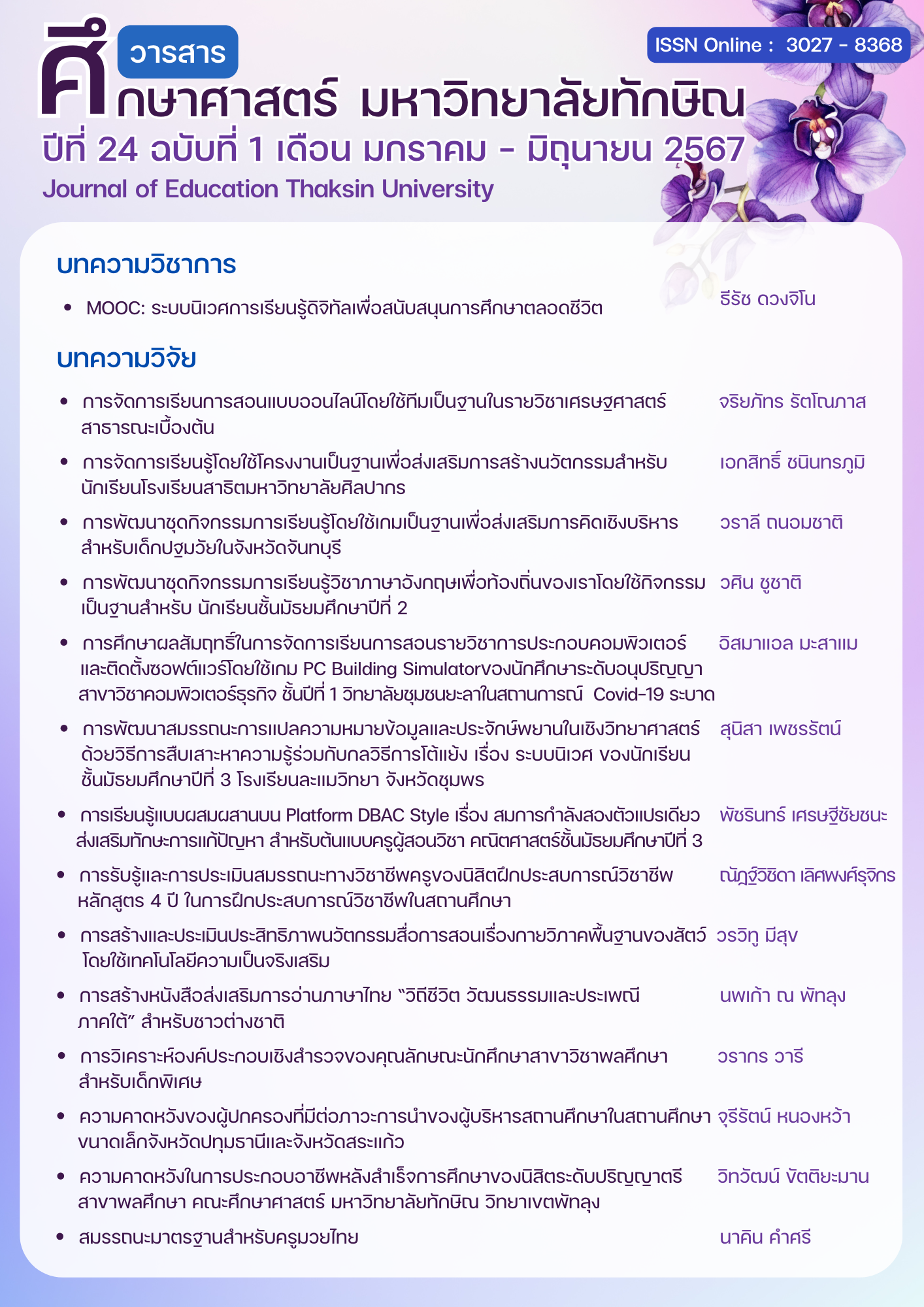การสร้างและประเมินประสิทธิภาพนวัตกรรมสื่อการสอน เรื่องกายวิภาคพื้นฐานของสัตว์ โดยใช้เทคโนโลยีความเป็นจริงเสริม
Main Article Content
บทคัดย่อ
งานวิจัยครั้งนี้มีวัตถุประสงค์เพื่อ 1) สร้างสื่อการสอนเรื่องกายวิภาคพื้นฐานของสัตว์ด้วยเทคโนโลยีความเป็นจริงเสริม 2) นำสื่อการสอนมาใช้ในวิชาชีววิทยาแทนการใช้สัตว์
ทดลอง 3) ประเมินความพึงพอใจของผู้เรียนต่อสื่อการสอน ตัวอย่างการวิจัยเป็นนักศึกษามหาวิทยาลัยเทคโนโลยีราชมงคลศรีวิชัยที่เรียนรายวิชาชีววิทยาในปีการศึกษา 2565 แบ่งเป็นกลุ่มควบคุม 26 คน และกลุ่มทดลอง 24 คน โดยสุ่มตามความสะดวก เครื่องมือที่ใช้ได้แก่ 1) แผนการสอนประกอบการใช้สื่อ 2) สื่อการสอนเรื่องกายวิภาคพื้นฐานของสัตว์ด้วยเทคโนโลยีความเป็นจริงเสริม 3) แบบทดสอบก่อนและหลังเรียน 4) แบบประเมินความพึงพอใจ
ผลจากการศึกษาพบว่านักศึกษากลุ่มทดลองและกลุ่มควบคุมมีความแตกต่างของคะแนนก่อนและหลังเรียนอย่างมีนัยสำคัญยิ่ง (p = 0.00) โดยกลุ่มทดลองและกลุ่มควบคุมมีความต่างของคะแนน 12.31±3.84 และ 7.58±5.42 ตามลำดับ เมื่อเปรียบเทียบระหว่างกลุ่มทดลองและกลุ่มควบคุมพบว่า กลุ่มทดลองมีคะแนนเฉลี่ยหลัง เรียน และความต่างคะแนนก่อนและหลังเรียนสูงกว่ากลุ่มควบคุมอย่างมีนัยสำคัญยิ่ง (p = 0.00) โดยคะแนนสอบหลังเรียนเฉลี่ยของกลุ่มทดลองและกลุ่มควบคุม คือ 20.10±2.96 และ 13.92±4.04 ตามลำดับ ความต่างคะแนนสอบก่อนและหลังเรียนของกลุ่มทดลองและกลุ่มควบคุมคือ 12.31±3.84 และ 7.58±5.42 ตามลำดับ นอกจากนี้นักศึกษายังมีความพึงพอใจต่อสื่อการเรียนรู้ในระดับ ดีมาก (4.96 ± 0.04) สื่อการสอนกายวิภาคพื้นฐานของสัตว์ด้วยเทคโนโลยีความเป็นจริงเสริมดึงดูดความสนใจผู้เรียนได้ดี และเหมาะกับสถานการณ์ปัจจุบัน อย่างไรก็ตาม ข้อจำกัดของสื่อนี้คือใช้ไม่ได้กับอุปกรณ์โทรศัพท์เคลื่อนที่บางรุ่นที่ไม่รองรับแอพพลิเคชันเทคโนโลยีความเป็นจริงเสริม
Article Details

อนุญาตภายใต้เงื่อนไข Creative Commons Attribution-NonCommercial-NoDerivatives 4.0 International License.
ในกรณีที่กองบรรณาธิการ หรือผู้เชี่ยวชาญ ซึ่งได้รับเชิญให้เป็นผู้ตรวจบทความวิจัย หรือ บทความทางวิชาการมีความเห็นว่าควรแก้ไขความบกพร่อง ทางกองบรรณาธิการจะส่งต้นฉบับให้ ผู้เขียนพิจารณาจัดการแก้ไขให้เหมาะสมก่อนที่จะลงพิมพ์ ทั้งนี้ กองบรรณาธิการจะยึดถือความคิด เห็นของผู้เชี่ยวชาญเป็นเกณฑ์
เอกสารอ้างอิง
Aivelo, T., & Uitto, A. (2016). Digital Gaming for Evalutionary Biology Learning the Case Study of Parasite Race, an Augmented Reality Location-based Game. Lumat. 4(1), 1-26. https://doi.org/10.31129/LUMAT.4.1.3
Azuma, R., Baillot, Y., Behringer, R., Feiner, S., Julier, S., & MacIntyre, B. (2001). Recent Advances in Augmented Reality. IEEE Computer Graphic Application 21(6): 34-47. https://doi.org/10.1109/38.963459
Budiman, R. D. A. (2016). Developing Learning Media Based on Augmented Reality (AR) to Improve Learning Motivation. Journal of Education, Teaching and Learning. 1(2), 2477-4878. https://doi.org/10.26737/jetl.v1i2.45
Chang, R., Chung, L., & Huang, Y. (2013). Developing an Interactive Augmented Reality System as a Complement to Plant Education and Comparing Its Effectiveness with Video Learning. Interactive Learning Environments. 24(6), 1245-1264. https://doi.org/10.1080/10494820.2014.982131
Godoy, C. Jr. H. (2020). Augmented Reality for Education: A Review. International Journal of Innovative Science and Research Technology. 5(6), 39-45. https://doi.org/10.38124/IJISRT20JUN256
Holzinger, A., Nischelwitzer, A., & Meisenberger, M. (2005). Lifelong-learning support by m-learning: example scenarios. eLearn. 2005(11): doi: 10.1145/1125180.1125284
Jamali, S. S., Shiratuddin, M. F., Wong, K. W., & Oskam, C. L. (2015). Utilizing Mobile-Augmented Reality for Learning Human Anatomy. Procedia-Social and Behavioral Sciences. 2015(197), 659-668. https://doi.org/10.1016/j.sbspro.2015.07.054
Kesim, M., & Ozarslan, Y. (2012). Augmented Reality in Education: Current Technologies and the Potential for Education. Procedia – Social and Behavioral Sciences. 47(2012), 297-302. https://doi.org/10.1016/j.sbspro.2012.06.654
Likert, R. (1967). The Method of Constructing and Attitude Scale. In Fishbeic, M. (Ed.), Attitude Theory and Measurement (pp. 90-95). New York: Wiley & Son. https://doi.org/10.4324/9781315128948-23
National Research Ethics Committees. (2019). Ethical Guidelines for the Use of Animals in Research. https://www.forskningsetikk.no/en/guidelines/science-and-technology/ethical-guidelines-for-the-use-of-animals-in-research/.
Nuanmeesri, S., Kadmateekarun, P., & Poomhiran, L. (2019). Augmented Reality to Teach Human Heart Anatomy and Blood Flow. The Turkish Online Journal of Educational Technology 2019(18), 15-24.
Radu, I. (2014). Augmented Reality in Education: A Meta-review and Cross-media Analysis. Personal and Ubiquitous Computing. 18(6), 1533-1543. https://doi.org/10.1007/s00779-013-0747-y
Santos, M. E., Lubke, A. W., Taketomi, T., Yamamoto, G., Rodrigo, M. M. T., Sandor, C., & Kato, H. (2016). Augmented Reality as Multimedia: The Case for Situated Vocabulary Learning. Research and Practice in Technology Enhanced Learning. 11(1), 1-23. https://doi.org/10.1186/s41039-016-0028-2
Shelton, B. E., & Hedley, N. R. (2002, 29 September). Using Augmented Reality for Teaching Earth-Sun Relationship to Undergraduate Geographic Students. The First IEEE International Augmented Reality Toolkit. Darmstadt, Germany. https://doi.org/10.1109/ART.2002.1106948
Suwancharas, T. (2016). Development of Multimedia using Augmented Reality (AR) for Improving Undergraduates’ English Listening Skill. APHEIT Journal. 5(2), 2-13.
Weng, C., Otanga, S., Christianto, S. M., & Chu, R. J. (2019). Enhancing Students’ Biology Learning by Using Augmented Reality as a Learning Supplement. Journal of Educational Computing Research. 58(4), 1-14. https://doi.org/10.1177/0735633119884213
Yapici, I., & Karakoyun, F. (2021). Using Augmented Reality in Biology Teaching. Malaysian Online Journal of Educational Technology. 9(3), 40-51. https://doi.org/10.52380/mojet.2021.9.3.286


